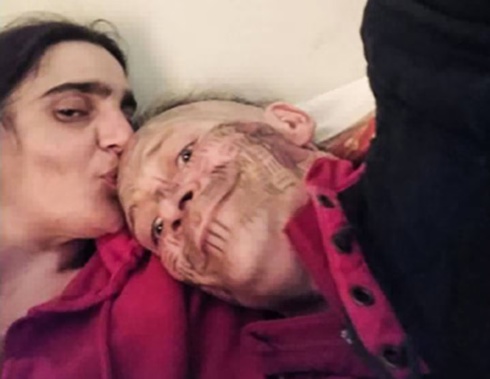
The man accused of murdering a former gang member at a Christchurch housing complex admitted part of the fatal attack when spoken to by police, saying he “chose to stay alive” when the other man “raged out” at him after taking meth.
Motu Smith is accused of beating Daniel Hawkins in the bedroom of his Sydenham unit, inflicting severe head injuries then cutting his throat and stabbing his neck.
He then took off in the alleged victim’s car, leaving him to die on his bed in a pool of his own blood.
The Crown says Smith’s actions were part of a “spree” of offending during which Smith violently attacked two other men - also fleeing in their vehicles.
But Smith says he was acting in “self-defence” when he injured Hawkins.
/cloudfront-ap-southeast-2.images.arcpublishing.com/nzme/XRLG2MZZ3JFABDDC3HXIC67UYI.jpg)
Kenneth Daniel Hawkins - known as Daniel - was allegedly murdered in his Christchurch home.
Emergency services were called to a community housing complex off Brougham Street about 3pm on April 24, 2021.
They found Kenneth Daniel Hawkins - known as Daniel - in his unit with critical injuries.
He died a short time later.
Motu Smith, who was living at the complex with his mother at the time, was charged with murdering Hawkins.
He has pleaded not guilty to that charge.
However, this morning he changed his plea and admitted a raft of other charges:
- Stealing Hawkins’ car on the day of the alleged murder;
- Stealing the car of a second man in Christchurch on the day of the alleged murder;
- Stealing a man’s car in Akaroa on the day of the alleged murder;
- Strangling a man and taking his $40,000 car the day before the alleged murder;
- Giving false information to police.
Justice Jonathan Eaton began the trial - expected to take three weeks - by addressing the jury.
He told the eight men and four women about the trial process and their roles and responsibilities.
Prosecutor Sean Mallett then opened the Crown case by outlining the allegations against Smith.
He explained while Smith would mount a defence of self-defence, that was simply not viable.
He said Smith had admitted committing numerous similar offences before and after the alleged murder.
“He violently attacked three men, choking two and killing the third ... [in a] spree of offending,” he said.
The first incident: A violent attack
Mallett said Smith started a new job 10 days before the alleged murder and was working on a construction site at Lincoln.
A man working in the site office - a portacom - heard the door of his ute open and close just outside.
He looked outside and saw Smith standing beside the vehicle.
Smith said he’d seen the door open and simply closed it.
The man thought nothing of it and went back inside. Ten minutes later, Smith walked in.
Mallett said the pair engaged in “a brief period of small talk” and the man showed Smith the site plans.
“Without any warning or provocation, he put the victim into a chokehold from behind … [He] had one arm around his neck, using his second arm to pull the first tighter,” he said.
Smith’s force lifted the victim from his seat and both fell to the ground.
He continued to choke the victim, whose eyesight went “blurry”, and then started to punch him with one arm as he tried to “increase the grip around his neck” with the other.
The victim managed to free one hand and gouged at Smith’s eye. Smith “relinquished” and got to his feet, picking up a 23cm piece of wood that had splintered from a chair during the tousle.
He “began advancing” on the victim, demanding to know: “Where is your sh**?”
Smith then took the victim’s phone and fled in his ute after locking him in the portacom.
The victim managed to escape through a window and flagged down another worker for help.
The second incident: A ‘mental episode’
At 4am, a man living at a rural property in Tai Tapu woke to his dogs barking.
He got up to investigate and saw headlight beams in his driveway.
Suspecting a vehicle had broken down, he approached and found Smith standing next to a ute.
He spoke to Smith, who “gave a startled groan” before he confirmed he’d broken down and asked for a tow rope.
The man was concerned and went back to the house, called 111 and passed on the ute’s registration number.
Police arrived soon after and arrested Smith for stealing the vehicle.
At the police station, Smith told police he’d had “a mental episode”.
At that stage, the victim from the portacom had not been spoken to and there were “no concerns” about Smith.
/cloudfront-ap-southeast-2.images.arcpublishing.com/nzme/7VYOTDSRYZGZ5PAHBNZNKJURXA.jpg)
Motu Smith. Photo / Chris Skelton / The Press
He was charged with stealing the ute and released.
As he left the police station, he was caught on CCTV cameras dumping a backpack in an empty lot and a hoodie in a bin.
He then went home to the housing complex via Pak’nSave, where he purchased cigarettes.
The third incident: The alleged murder
Later that morning, Smith asked a neighbour to take him to the supermarket.
When he returned to the complex, he chose to enter Hawkins’ unit.
Mallett said there was “no pre-existing relationship” between the men, no animosity.
“They were seemingly unknown to each other. There was no record of any prior contact or communication between the men,” he told the jury.
“Mr Smith told police he did not know who Mr Hawkins was.”
Mallett said while no one witnessed what happened in Hawkin’s unit, “autopsy and forensic results” allowed the Crown to “draw important conclusions”.
He said Hawkins was found by a neighbour - who will give evidence later in the trial - after 3pm that day.
He was lying on his bed in a pool of blood with his throat cut.
He was “making gurgling noises” and was still warm.
But when paramedics arrived soon afterwards, Hawkins was declared dead.
Mallett said Hawkins “suffered significant blunt force trauma to his head” - a force so strong it broke both eye sockets and damaged his brain.
He had a 12cm-long, 4cm-deep cut on the front of his throat and had received a 5 to 7cm-deep stab wound to his neck that had pierced both his jugular and oesophagus.
“The Crown case - supported by findings of pathologist - is that the knife wounds to neck and throat occurred after Mr Hawkins had been rendered unconscious and incapacitated by the blunt force wounds to his head,” said Mallett.
“Mr Hawkins had no blood on his hands ... at no point was he conscious and able to try to staunch the bleeding. Put simply, Mr Hawkins was beaten to unconsciousness, and while incapacitated - and with no way to defend himself - he had his throat cut.”
Mallett said Hawkins’ head injury was “severe enough to have caused his death in their own right”.
The knife wounds could have been survivable if he had been able to seek help.
His cause of death was a combination of head injury and blood loss.
After allegedly murdering Hawkins, Smith fled in his car - but not before he left a bloody palm print on a wardrobe door.
The fourth incident: Library attack
Smith drove Hawkins’ car - erratically and dangerously - to Halswell.
There he set the car and keys, a knife and his phone on fire.
“This was a deliberate but clumsy attempt [by] the defendant to destroy the evidence,” said Mallett.
/cloudfront-ap-southeast-2.images.arcpublishing.com/nzme/ZJLPPVFGTFCOBGCRF46R47Z7IY.jpg)
Justice Jonathan Eaton. Photo / Iain McGregor / The Press
Smith walked a short distance to the Halswell library, approaching a man who had just parked and was getting out of his car.
What happened next was recorded on the man’s dashboard camera.
“Mr Smith can be seen approaching ... and without warning striking him [in] the face, causing him to stumble backwards,” Mallett told the jury.
“He grabbed him from behind, put him in a headlock, choking him to the ground. He demanded ... [his] keys and phone.
“As [the victim] lay on the ground gasping for breath, Mr Smith took his phone and keys and fled the scene in his car.
“The whole assault took less than a minute.”
Incident five: To Akaroa and back
Smith drove to Akaroa, about one and a half hours from Christchurch across the hills.
He parked the stolen car at the local bowling club at 2.42pm and took another.
The owner had left it unlocked with the keys in the ignition while he was playing bowls.
Around this time, Hawkins was found by his neighbour.
Just after 4pm, Smith stopped at Prebbleton and purchased a mince-and-cheese pie.
Police were searching for him in relation to the stolen car he was driving - but Mallett said at that stage, the “spree” of offending “was not attributable to the same person”.
At 6.10pm, officers spotted the car and pulled Smith over.
He tried to pass himself off as his brother, but officers found his licence in the car and arrested him again.
Mallett said the lie was “a clumsy attempt to avoid responsibility”.
The police interview
Smith was interviewed by police and the jury will be played the five hours of footage later in the trial.
Mallett explained that for the “majority” of the interview, Smith “avoided questions put to him ... claiming instead to be hearing voices and expressing concerns that ‘the gangs were out to get him’.
“At the end of interview, he made important admissions. He admitted going inside Daniel Hawkins’ unit. He said the door was open and, despite not knowing who he was, went in and took the keys.
“He claimed Mr Hawkins was smoking meth and that ‘he raged out at me’ ... he further claimed Mr Hawkins grabbed a knife and tried to stab him.
“He said he felt scared and ‘chose to stay alive’. He admitted attacking him by choking him, but he did not admit cutting his throat.”
The trial at the High Court in Christchurch is ongoing. Photo / George Heard
The defence: Self-defence and reasonable force
Defence lawyer Abbie Hollingworth also gave a brief opening statement on behalf of Smith.
She said it was crucial for the jury to keep an open mind and not make any decision until they had heard all the evidence.
She said her client was an innocent man - and would remain so unless the Crown proved its case.
The defence was adamant the Crown would not convince the jury Smith was guilty of murder.
Hollingworth said Smith acknowledged he was guilty of some of the offending and “takes responsibility for that behaviour”.
“Hence his admission of guilt,” she said.
“What was going on for him when he did those things will come to light during this trial ... What he does not accept is the charge of murder.”
She said the jury, after hearing the Crown’s opening, may have thought the case was “open and shut”.
“But is it not. You must not jump to any conclusions yet,” she said.
“The most important issue for me to flag is that one of self-defence ... Mr Smith accepts he got into [an] altercation with Mr Hawkins, assaulted him, and he later died.
“However, you will hear that Motu Smith told police [Hawkins] used force ... that he thought he was going to be killed so he defended himself.”
Hollingworth explained briefly that under New Zealand law, reasonable force is allowed when a person legitimately believes their life or safety is in danger.
The jury will hear more on that when the defence calls evidence.
The trial is set down for three weeks, and during that time the jury will hear from a number of witnesses, including people who lived at the housing complex, forensic experts and police officers who worked on the investigation.
Who was Dan Hawkins?
Hawkins was a former member of the Mongrel Mob gang and was facing active charges when he died.
Nyomi Coleman and Hawkins had been in a relationship for about a year.
Court orders were in place when he died to prevent him from contacting her.
However, she told the Herald despite their troubled relationship, she loved and adored Hawkins and had hoped for a long and happy future with him.
“He was my partner, and he is so missed and wanted so much … he will forever be Dan, my man.”
/cloudfront-ap-southeast-2.images.arcpublishing.com/nzme/XRLG2MZZ3JFABDDC3HXIC67UYI.jpg)
Nyomi Coleman and partner Kenneth Daniel Hawkins.
Coleman said Hawkins was trying to turn his life around.
She was raising her child alone.
They had their issues, but Coleman said their love was strong.
“He made me feel wanted, made us feel like a family,” she told the Herald.
“That’s something I’ve never had.”
Hawkins was facing family violence charges concerning an incident involving Coleman.
The pair had not seen each other for about six weeks, a condition of his electronically monitored bail conditions.
Coleman was missing Hawkins terribly, then got a phone call from police to say he had died.
“I woke up to police telling me [he was dead],” she said.
“It was heartbreaking. I haven’t slept since, I don’t think I am making any sense … My daughter and I went to his house today and left flowers and a love-heart sign with words.
“He was such a cuddly bear, taken away too soon. No matter what - nobody deserves to be taken this way.”
Coleman acknowledged her partner’s dark past, his previous convictions, his violence and his gang connections.
But she said he was committed to a better life.
“He had such a caring side … we both had issues, and he was on current charges for assaulting me, but it would never take away the love I have for him,” she said.
“Nothing will ever replace him or the happiness he brought - that smile of his was not [seen often], but it was beautiful.
“His beautiful, handsome smile … his affection, his arms wrapped around me. He knew how to comfort me at the right times.”
Take your Radio, Podcasts and Music with you

/cloudfront-ap-southeast-2.images.arcpublishing.com/nzme/FFU5FFLZFNAT5G67TQCI6AHUMI.JPG)








